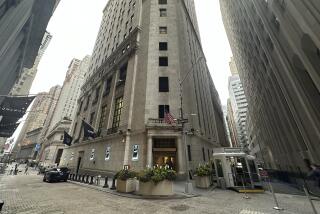Jobless Rate Hits 5.9%; Payroll Growth Weak
WASHINGTON — The nation’s unemployment rate rose to 5.9% in June and employers hired fewer than half the workers they had been expected to, the Labor Department said Friday. The figures show the economy recovering at a maddeningly slow pace.
Department officials said U.S. companies added 36,000 workers last month, compared with the 75,000 that had been predicted. And officials revised previous months’ job gains dating to February, when the labor market was originally thought to have begun a comeback. The department initially said employers added 66,000 workers that month; it now said they trimmed 165,000.
“These are not very promising figures,” said Richard Yamarone, chief economist with New York-based Argus Research Corp. “Employment growth is the single most important statistic for this recovery because new jobs translate into more income and more spending.
“But these numbers make you think there isn’t going to be much of either,” he said.
There were a few bright spots in the new report. The length of the average workweek rose slightly, which usually is a prelude to new hiring. Wages also rose, with the average hourly earnings for production and nonsupervisory workers, who account for about 80% of the nation’s labor force, jumping 6 cents in June to $14.76.
For a few analysts, that was enough. “The worst of the massive layoffs are behind us,” said Stan Shipley, a senior economist with Merrill Lynch & Co. in New York. “You’re going to see payroll job growth coming back strongly” in the fall.
U.S. stocks staged a powerful rally Friday, with the Dow Jones industrial average posting its biggest gain in nine months. The Dow jumped 324.53 points, or 3.6%, to close at 9379.5, and other major market measures rose even more steeply.
But most analysts said the new jobs report played no role in the run-up, and warned that, with firms such as WorldCom Inc. and Electronic Data Systems Inc. announcing big job cuts this week and most industries reporting little or no payroll expansion, prospects for a quick and strong recovery appear to be dimming.
“All these things argue for the coming decade being sub-1990s,” said Peter E. Kretzmer, a senior economist with Bank of America Corp. in New York.
June’s 5.9% jobless rate was only fractionally above the previous month’s 5.8% rate but was substantially above June 2001’s 4.6% rate.
About 8.4 million Americans were unemployed during the month, almost 1 million more than a year ago.
The unemployment rate among Latinos rose to 7.4% last month from 7% in May. The rate among African Americans climbed half a point to 10.7%, the department said.
The number of people unemployed for six months or more hit an eight-year high of 1.67 million in June. The average length of an out-of-work stint hit a six-year high of 17.3 weeks.
Regular unemployment compensation runs out at the end of six months. After that, jobless workers must rely on various extension programs that critics say operate in drastically different ways in various states.
“Six hundred thousand workers will run out of benefits in the next few months because of major gaps in the federal extension program,” said Maurice Emsellem, an official with the National Employment Law Project, an activist group that helps low-income workers obtain coverage.
Emsellem said that of 14 states with unemployment rates above 6%, only two--Washington and Oregon--would qualify for additional benefits under a federally funded extension program.
He said the rest would have to wind down their extension programs. Among them are California and Pennsylvania.
Although up from May, the nation’s nonfarm payrolls changed little in recent months, totaling 130.7 million in June.
In contrast, they were falling by an average of 160,000 workers a month from the March 2001 start of the current recession through February.
Some of the worst losses have occurred in manufacturing, which shed 23,000 jobs last month and almost 1.1 million over the last year. The cutbacks have not fallen exclusively on blue-collar or low-skill workers.
The latest figures show there were almost 150,000 more jobless college graduates than jobless high school dropouts last month.
Employers’ failure to create more jobs in June was widely viewed as evidence of the economy’s continued weakness.
Although the gross domestic product, the principal measure of the nation’s output of goods and services, grew at an unexpectedly strong 6.1% annual clip in the first three months of the year, its growth has slowed to perhaps 2% or less.
Analysts said the combination of weak growth and a stock market that has fallen sharply, Friday’s rally notwithstanding, makes it unlikely that the Federal Reserve will raise interest rates soon.
Central bank policymakers decided last week to keep their signal-sending federal funds rate at a four-decade low of 1.75%, saying the economy has lost momentum.
Although the policymakers said they expected consumer and business spending to “pick up over the coming quarters,” they warned that “the degree of the strengthening remains uncertain.”
More to Read
Inside the business of entertainment
The Wide Shot brings you news, analysis and insights on everything from streaming wars to production — and what it all means for the future.
You may occasionally receive promotional content from the Los Angeles Times.










